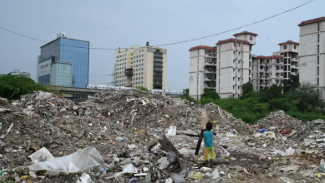In early August 2025, a single, sharply worded social media post turned a festering local nuisance in Gurugram into an administrative sprint. A Delhi-based woman, Anuradha Tiwari, posted a photograph of a large roadside garbage heap and called for volunteers to collect the trash and dump it “outside ministers’ bungalows.” The provocation was deliberate, the frustration palpable—and the results were immediate.
Within hours of the post going viral on X (formerly Twitter), the Municipal Corporation of Gurugram (MCG) dispatched crews to the spot and cleared the area, later sharing proof-of-cleaning images to confirm action. Multiple outlets chronicled the chain reaction: outrage → virality → rapid remediation. It was a crisp demonstration of how visibility and public pressure can compress civic timelines from weeks to mere hours.
The episode resonated so widely because it wasn’t a one-off grievance in a spotless city. Residents have been documenting Gurugram’s waste management troubles for months: overflowing roadside dumps, inconsistent pickup schedules, and the persistent scourge of illegal dumping. Reporters have watched as car after car casually offloaded polybags on vacant plots, normalizing what should be unacceptable. On social feeds and neighborhood groups, the images piled up alongside complaints that the system—contractors, monitoring, and enforcement—wasn’t keeping pace with the city’s growth. The viral post struck a nerve precisely because it captured a routine indignity that thousands recognized.
That pressure has coincided with official attempts to change course. The MCG recently signaled a tougher stance on illegal dumping by invoking Section 15 of the Environment (Protection) Act, 1986, which allows fines and even imprisonment for violators. Vehicles caught dumping can be seized and blacklisted; at least one contractor has already been fined ₹1 lakh after residents flagged an incident. Administrators have also been urged to strengthen segregation norms and hold bulk waste generators accountable—moves meant to shift the burden from citizens who have been playing vigilante photographers to institutions tasked with maintaining order.
At the same time, senior state officials have parachuted in to coordinate a cross-agency clean-up, acknowledging that the sanitation mess isn’t isolated to one department. For nearly a week, Haryana’s Chief Principal Secretary to the Chief Minister camped in Gurugram to hammer out an action plan with the MCG, GMDA, HSVP, DHBVN, and the district administration. The agenda spanned garbage disposal, road repairs, and even deterrence for waste burning—an attempt to stitch together fragmented responsibilities into a coherent response. The message was clear: the city’s reputation, public health, and quality of life hinge on getting basics right, consistently.
Digital channels have become a crucial part of this new feedback loop. In one recent case, a Gurugram resident filed multiple complaints on the Swachhata-MoHUA app; the waste was cleared the same day, and the experience—posted online—sparked a mini-lesson on how to use official tech to trigger service delivery. Beyond individual apps, even community forums like Reddit’s r/gurgaon have turned into knowledge exchanges where residents trade tactics for escalation and share contact points that work. The social media post that went viral sits within this broader trend: citizens are learning how to turn attention into action.
None of this, however, should distract from the deeper structural challenge that looms just beyond the neighborhood heap: the Bandhwari landfill. Its chronic fires, methane build-up, and toxic fumes have drawn rebukes from courts and green tribunals. The persistence of such systemic failures reminds us that cleaning a single stretch is necessary but insufficient. A citywide solution requires sustained investment in segregation, collection, transfer stations, scientific processing, and transparent contractor oversight. The attention a viral post generates can open the door; only relentless governance—and citizen cooperation—can keep it from slamming shut again.
So what, precisely, happened in this case? A resident converted private exasperation into a public challenge. The post’s audacity—“let’s dump it at the powerful’s doorstep”—supplied the spark; the image supplied the proof; and the chorus of replies supplied momentum. Faced with an online snowball that could quickly turn reputational, local authorities did what residents had been requesting all along: they deployed, they cleaned, they communicated. The speed of that sequence—documented by national media and amplified by social accounts—proved how accountability can be catalyzed when administrators know citizens are watching and the press is ready to verify.
Yet the moral of the story isn’t that shaming is the only route to service. It’s that visibility, clear asks, and channel fluency matter. When residents pair heat (viral visibility) with light (specific location details, timestamps, and follow-up proof), action becomes easier to demand and harder to deflect. Gurgaon’s civic story is being rewritten in real time: government experiments with sterner laws and integrated control rooms; technologists prototype citizen-reporting platforms; and ordinary people discover how to turn a camera phone into a civic lever. The road got cleaned because one person refused to scroll past the mess. The city will get cleaner, and stay that way, when thousands more decide to do the same—and when institutions meet that energy with systems that work whether or not a post goes viral.
If one post can sweep a street, consistent policy and public participation can reclaim a city. Gurugram’s August clean-up is a case study in how attention, technology, and responsive governance can converge—briefly—to make things work as they should. The next step is making that convergence the norm rather than the exception. Keep Reading Foramz.com for more such blogs.


Leave a Reply